Across our network we work with schools who are all at different stages of setting up and delivering primary language learning and each year we welcome new schools who want to set off on their own individual school's language learning journey.

This year these specific
"Beginning with languages "
blogs will try to offer "bite size chunks" of indirect help and support to schools, who are doing exactly that .... just setting off and implementing a language learning curriculum
.
In September this year I wrote :
beginning with languages blog 1
and in October

Your checklists so far have been:
Sept - Oct (first half term) Checklist
- It's all about establishing a whole school support system for all your staff
- It's about small steps and simple language learning
- It's about children and staff beginning to enjoy language learning
Mid October an additional new checklist bullet point!
- So how are you all getting on? How do you know that primary languages are being implemented in all the classes and are the teachers and children having fun in their learning?
And now your new checklist bullet points for November are.........
- How can you build in "revisiting" opportunities to build the children and staff's confidence with the language you introduced last half term - probably greetings, numbers 0-11, simple questions and answers about names and feelings and perhaps some colours will be in this list from last half term? What about a game like Bingo or Splat or maybe a game of Quiz Quiz Swap (Quiz Quiz Trade) around the classroom where children ask questions and swap cards with someone else as they move around the room and greet/ ask names and feelings and say farewells.Or why not try out a simple colours and firework song and activity like this one Colours and rockets particularly with the younger learners in KS1 and Y3/4

- This half term you can focus on celebrations too .There is Saint Nicolas Day at the start of December on the 6th December (here is some wikipedia information ) and then there is Christmas of course!Why not select a simple Christmas song now and start to practise in your classes ready for a whole school target language performance in the school Christmas assembly?
Continuing to make progress and to upskill staff and children in the target language
- Make sure that teachers and children continue to make progress.
- Introduce a new focus for example n the month of November practise and develop their language learning skills.Take a look at months and days and practise with the children ways to remember the new words, looking for cognates and semi- cognates (words that look similar)
- Possible songs to support you are below :
French month
s
:
Spanish months
:
German months
:
- Begin to look for ways to link language learning to another area of the curriculum to embed language learning as an integral part of learning for instance why not try out a "physical bar chart" based on months and birthdays. Take a look here Physical primary target languages maths
Looking for a Christmas song for all the school?
Here are three target language examples with sound files and words on the screen to support all staff to familiar tunes and which are international Christmas songs/carols
Here is Jingle Bells in French:
and in spanish
or what about Stille Nacht (Silent Night) in German









